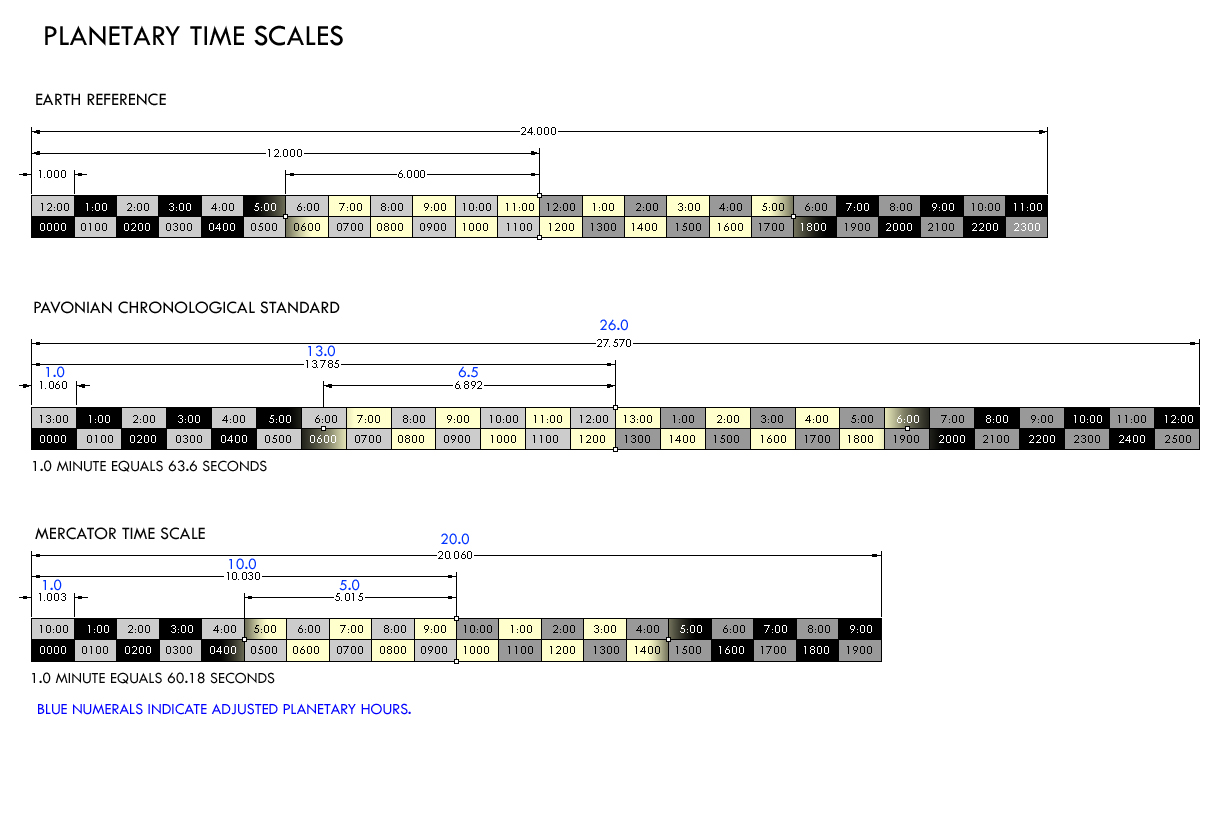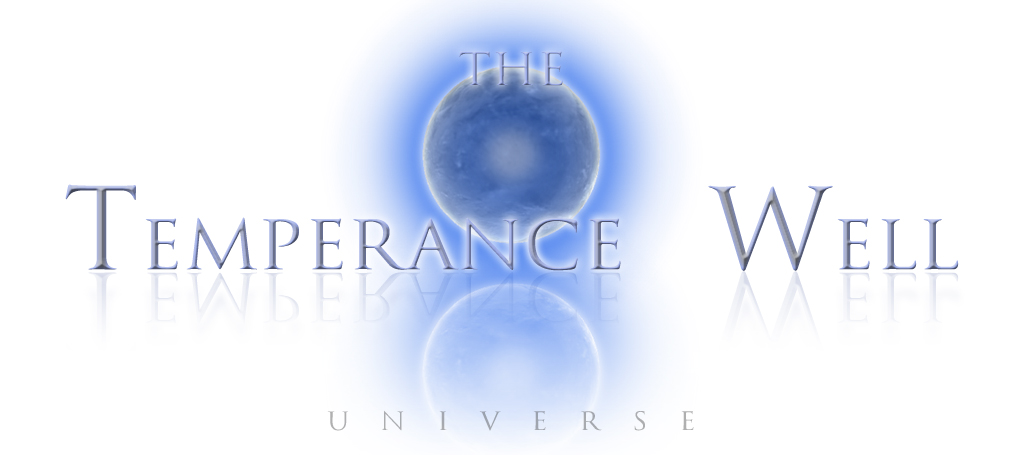Topic: Notes
In the pursuit of realism, time poses a challenge when writing about societies removed from Earth whereby Earth is no longer a standard. It fails to be practical to keep old standards of time, with the exception of the second. It is necessary to develop clock and calendar system as a new time standard for these stories, which can get hectic when dealing with ages. In most cases I try to avoid assigning year ages to the characters, but in most cases, when a character is referencing years, it is a Pavonan year, which is longer than ours.
The following chart is part of my spreadsheet for calculating time.
| Year | |||||||
| hours | min | sec | sidereal | days | days | ||
| Earth | 23.000 | 56.000 | 4.100 | 23.934 | 0.997 | 365.25637 | |
| Pavona | 27.000 | 34.000 | 12.400 | 27.570 | 1.149 | 432.543 | 496.88577 |
| earth days | pavonan days | ||||||
And because Pavona is an Earth-like planet, I mean it to be very much like Earth, including similar axial tilt to generate similar seasons. Thus I have determined that a season is 124.25 Pavonan days, a month has either 41 or 42 Pav. days, and a Pav. year has 71 weeks. Weeks are still seven days, although with the evolution of language the names of the days would change. I haven't given names for them, so in the interim the real names are adeqate placeholders. I don't have names for months either. When I need a name, I'll invent one.
I made this reference image as a quick-look guide to determin hours and time of day.


I made this using Rhino 3D modeling software, which when substituting time for distance, did all my calculating for me. Colored it in Photoshop. I was surprised that Mercator's hour is so close to Earth standard, so that when I write about hours on that planet, I pratically mean an hour. Make note that on Pavona, analog clock faces are numbered to 13. On Mercator, to 10. Bear in mind the duration of the second has not changed, but minutes and hence hours on both these worlds have increased, which is why 3 and a half extra hours only equates to one added number on the clock face.
And yes, I have devised a calendar. It was excriuciating. I'll tack it on to the end. I do have a work-in-progress timeline for the stories on the Mercator Arc:
| PE | Earth eqv | |
| Pavona colonized | 0 | 0 |
| Technical loss | 1029 | 1400 |
| Calisennial Era s. | 1825 | 2483 |
| Calisennial Era e. | 2156 | 2933 |
| Pre Modern Era s. | 2157 | 2934 |
| H. Mercator b. | 2203 | 2997 |
| E. Sidow b. | 2290 | 3115 |
| Deralto Expo s. | 2304 | 3134 |
| Cross planet disc. | 2314 | 3148 |
| Mercator disc. | 2320 | 3156 |
| H. Mercator d. | 2323 | 3160 |
| E. Sidow d. | 2324 | 3162 |
| Deralto Expo e. | 2326 | 3164 |
| Fed. Architecture | 2389 | 3250 |
| Overthrow War s. | 2474 | 3366 |
| Overthrow War e. | 2477 | 3370 |
| Current Year (MA) | 2536 | 345 |
Because I can't help but to think of durations by our clocks and calendars, I have to calculate from Earth to Pavona time. And since 1 year on Mercator is 33.03 our years, I haven't begun to tackle how they track time. I would image they keep to Pavonan when determining age.
The Calendar.
| S | M | T | W | T | F | S | S | M | T | W | T | F | S | S | M | T | W | T | F | S | |||
| 1 | 1 | 2 | 3 | 4 | 5 | 6 | 7 | 2 | 1 | 3 | 1 | ||||||||||||
| 8 | 9 | 10 | 11 | 12 | 13 | 14 | 2 | 3 | 4 | 5 | 6 | 7 | 8 | 2 | 3 | 4 | 5 | 6 | 7 | 8 | |||
| 15 | 16 | 17 | 18 | 19 | 20 | 21 | 9 | 10 | 11 | 12 | 13 | 14 | 15 | 9 | 10 | 11 | 12 | 13 | 14 | 15 | |||
| 22 | 23 | 24 | 25 | 26 | 27 | 28 | 16 | 17 | 18 | 19 | 20 | 21 | 22 | 16 | 17 | 18 | 19 | 20 | 21 | 22 | |||
| 29 | 30 | 21 | 32 | 33 | 34 | 35 | 23 | 24 | 25 | 26 | 27 | 28 | 29 | 23 | 24 | 25 | 26 | 27 | 28 | 29 | |||
| 36 | 37 | 38 | 39 | 40 | 41 | 30 | 31 | 32 | 33 | 34 | 35 | 36 | 30 | 31 | 32 | 33 | 34 | 35 | 36 | ||||
| 37 | 38 | 39 | 40 | 41 | 42 | 37 | 38 | 39 | 40 | 41 | |||||||||||||
| 4 | 1 | 2 | 5 | 1 | 2 | 3 | 6 | 1 | 2 | 3 | |||||||||||||
| 3 | 4 | 5 | 6 | 7 | 8 | 9 | 4 | 5 | 6 | 7 | 8 | 9 | 10 | 4 | 5 | 6 | 7 | 8 | 9 | 10 | |||
| 10 | 11 | 12 | 13 | 14 | 15 | 16 | 11 | 12 | 13 | 14 | 15 | 16 | 17 | 11 | 12 | 13 | 14 | 15 | 16 | 17 | |||
| 17 | 18 | 19 | 20 | 21 | 22 | 23 | 18 | 19 | 20 | 21 | 22 | 23 | 24 | 18 | 19 | 20 | 21 | 22 | 23 | 24 | |||
| 24 | 25 | 26 | 27 | 28 | 29 | 30 | 25 | 26 | 27 | 28 | 29 | 30 | 31 | 25 | 26 | 25 | 26 | 27 | 28 | 29 | |||
| 31 | 32 | 33 | 34 | 35 | 36 | 37 | 32 | 33 | 34 | 35 | 36 | 37 | 38 | 30 | 31 | 32 | 33 | 34 | 35 | 36 | |||
| 38 | 39 | 40 | 41 | 39 | 40 | 41 | 42 | 37 | 38 | 39 | 40 | 41 | |||||||||||
| 7 | 1 | 2 | 8 | 1 | 2 | 3 | 9 | 1 | |||||||||||||||
| 3 | 4 | 5 | 6 | 7 | 8 | 9 | 4 | 5 | 6 | 7 | 8 | 9 | 10 | 2 | 3 | 4 | 5 | 6 | 7 | 8 | |||
| 10 | 11 | 12 | 13 | 14 | 15 | 16 | 11 | 12 | 13 | 14 | 15 | 16 | 17 | 9 | 10 | 11 | 12 | 13 | 14 | 15 | |||
| 17 | 18 | 19 | 20 | 21 | 22 | 23 | 18 | 19 | 20 | 21 | 22 | 23 | 24 | 16 | 17 | 18 | 19 | 20 | 21 | 22 | |||
| 24 | 25 | 26 | 27 | 28 | 29 | 30 | 25 | 26 | 25 | 26 | 27 | 28 | 29 | 23 | 24 | 25 | 26 | 27 | 28 | 29 | |||
| 31 | 32 | 33 | 34 | 35 | 36 | 37 | 30 | 31 | 32 | 33 | 34 | 35 | 36 | 30 | 31 | 32 | 33 | 34 | 35 | 36 | |||
| 38 | 39 | 40 | 41 | 37 | 38 | 39 | 40 | 41 | 42 | 37 | 38 | 39 | 40 | 41 | |||||||||
| 10 | 1 | 2 | 11 | 1 | 2 | 3 | 12 | 1 | |||||||||||||||
| 3 | 4 | 5 | 6 | 7 | 8 | 9 | 4 | 5 | 6 | 7 | 8 | 9 | 10 | 2 | 3 | 4 | 5 | 6 | 7 | 8 | |||
| 10 | 11 | 12 | 13 | 14 | 15 | 16 | 11 | 12 | 13 | 14 | 15 | 16 | 17 | 9 | 10 | 11 | 12 | 13 | 14 | 15 | |||
| 17 | 18 | 19 | 20 | 21 | 22 | 23 | 18 | 19 | 20 | 21 | 22 | 23 | 24 | 16 | 17 | 18 | 19 | 20 | 21 | 22 | |||
| 24 | 25 | 26 | 27 | 28 | 29 | 30 | 25 | 26 | 25 | 26 | 27 | 28 | 29 | 23 | 24 | 25 | 26 | 27 | 28 | 29 | |||
| 31 | 32 | 33 | 34 | 35 | 36 | 37 | 30 | 31 | 32 | 33 | 34 | 35 | 36 | 30 | 31 | 32 | 33 | 34 | 35 | 36 | |||
| 38 | 39 | 40 | 41 | 37 | 38 | 39 | 40 | 41 | 42 | 37 | 38 | 39 | 40 | 41 | 42 |
I wanted to make a perfect calendar where the last month dovetailed the first month, but new years will pick up where old one left off, just like ours.

